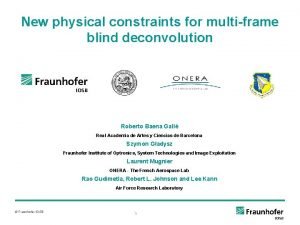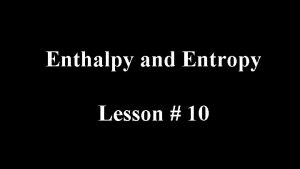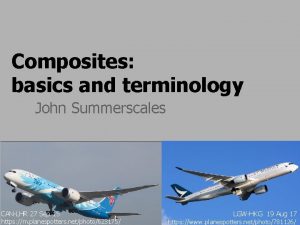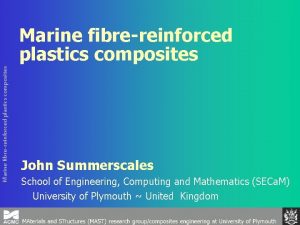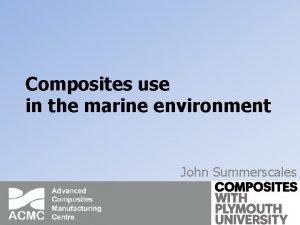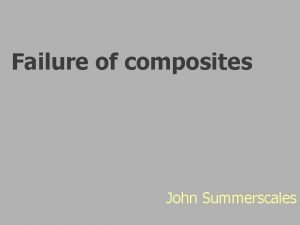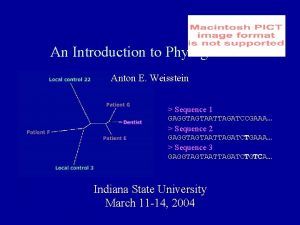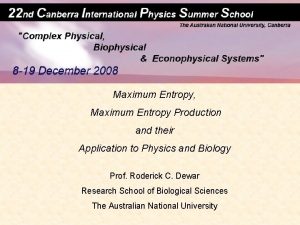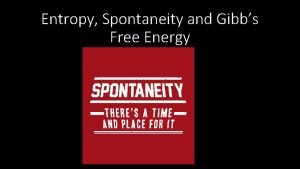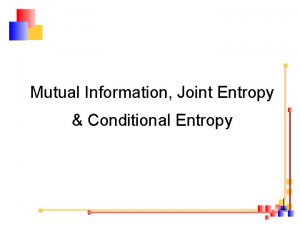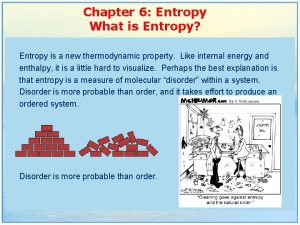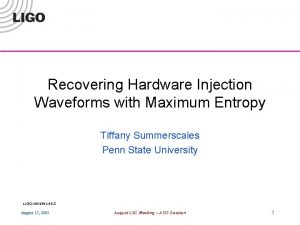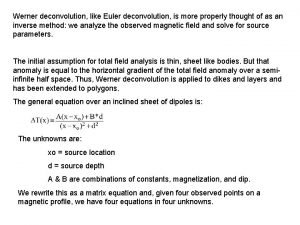Deconvolution and Inference Using Maximum Entropy Tiffany Summerscales











- Slides: 11

Deconvolution and Inference Using Maximum Entropy Tiffany Summerscales Penn State University May 20, 2005 Stats for GW Data Analysis 1

Motivation: Supernova Astronomy with Gravitational Waves • Problem 1: How do we recover a burst waveform? • Problem 2: When our models are incomplete, how do we associate the waveform with source physics? • Example - The physics involved in core-collapse supernovae remains largely uncertain » Progenitor structure and rotation, equation of state • Simulations generally do not incorporate all known physics » General relativity, neutrinos, convective motion, non-axisymmetric motion May 20, 2005 Stats for GW Data Analysis 2

Maximum Entropy • Problem 1: How do we recover the waveform? (deconvolution) • The detection process modifies the signal from its initial form hi • Detector response R includes projection onto the beam pattern as well as unequal response to various frequencies • Possible solution: maximum entropy – Bayesian approach to deconvolution used in radio astronomy, medical imaging, etc. • Want to maximize where I is any additional information such as noise levels, detector responses, etc May 20, 2005 Stats for GW Data Analysis 3

Maximum Entropy Cont. • The likelihood, assuming Gaussian noise is » Maximizing only the likelihood will cause fitting of noise • Set the prior » S related to Shannon Information Entropy » Entropy is a unique measure of uncertainty associated with a set of propositions » Entropy related to the log of the number of ways quanta of energy can be distributed in time to form the waveform » Maximizing entropy - being non-committal as possible about the signal within the constraints of what is known » Model m is the scale that relates entropy variations to signal amplitude • Maximizing May 20, 2005 equivalent to minimizing Stats for GW Data Analysis 4

Maximum Entropy Cont. • Minimize • • is a Lagrange parameter that balances being faithful to the signal (minimizing 2) an associated with constraint which can be formally established. In summary: half the • Example: May 20, 2005 Stats for GW Data Analysis 5

Maximum Entropy Performance, Weaker Signal • Weak feature recovery is possible • Maximum entropy an answer to deconvolution problem May 20, 2005 Stats for GW Data Analysis 6

Cross Correlation • Problem 2: When our models are incomplete, how do we associate the waveform with source physics? • Cross Correlation - select the model associated with the waveform having the greatest cross correlation with the recovered signal • Gives a qualitative indication of the source physics May 20, 2005 Stats for GW Data Analysis 7

Simulated Detection • Select Ott et al. waveform » 2 D core-collapse simulations restricted to the iron core, general relativity and neutrinos neglected » Simulations for a sampling of progenitor masses, amounts of differential rotation and angular momentum, and magnetic effects • Scale waveform amplitude to correspond to a supernova occurring at various distances. • Project onto LIGO Hanford 4 -km and Livingston 4 -km detector beam patterns with optimum sky location and orientation for Hanford • Convolve with detector responses and add white noise typical of amplitudes in most recent science run • Recover initial signal via maximum entropy and calculate cross correlations with all waveforms in catalog May 20, 2005 Stats for GW Data Analysis 8

Extracting Bounce Type • Calculated maximum cross correlation between recovered signal and catalog of waveforms • Highest cross correlation between recovered signal and original waveform (solid line) • Plot at right shows highest cross correlations between recovered signal and a waveform of each type. • Recovered signal has most in common with waveform of same bounce type (supranuclear bounce) May 20, 2005 Stats for GW Data Analysis 9

Extracting Mass • Plot at right shows cross correlation between reconstructed signal and waveforms from models with progenitors that differ only by mass • The reconstructed signal is most similar to the waveform with the same mass • Similar results for progenitor rotational parameters May 20, 2005 Stats for GW Data Analysis 10

Conclusions • Problem 1: How do we reconstruct waveforms from data? • Maximum entropy - Bayesian approach to deconvolution, successfully reconstructs signals • Problem 2: When our models are incomplete, how do we associate the waveform with source physics? • • Cross correlation between reconstructed and catalog waveforms provides a qualitative comparison between waveforms associated with different models Assigning confidences is still an open question • Maximum Entropy References: Maisinger, Hobson & Lasenby (2004) MNRAS 347, 339 Narayan & Nityananda (1986) ARA&A 24, 127 Mac. Kay (1992) Neural Comput 4, 415 May 20, 2005 Stats for GW Data Analysis 11

